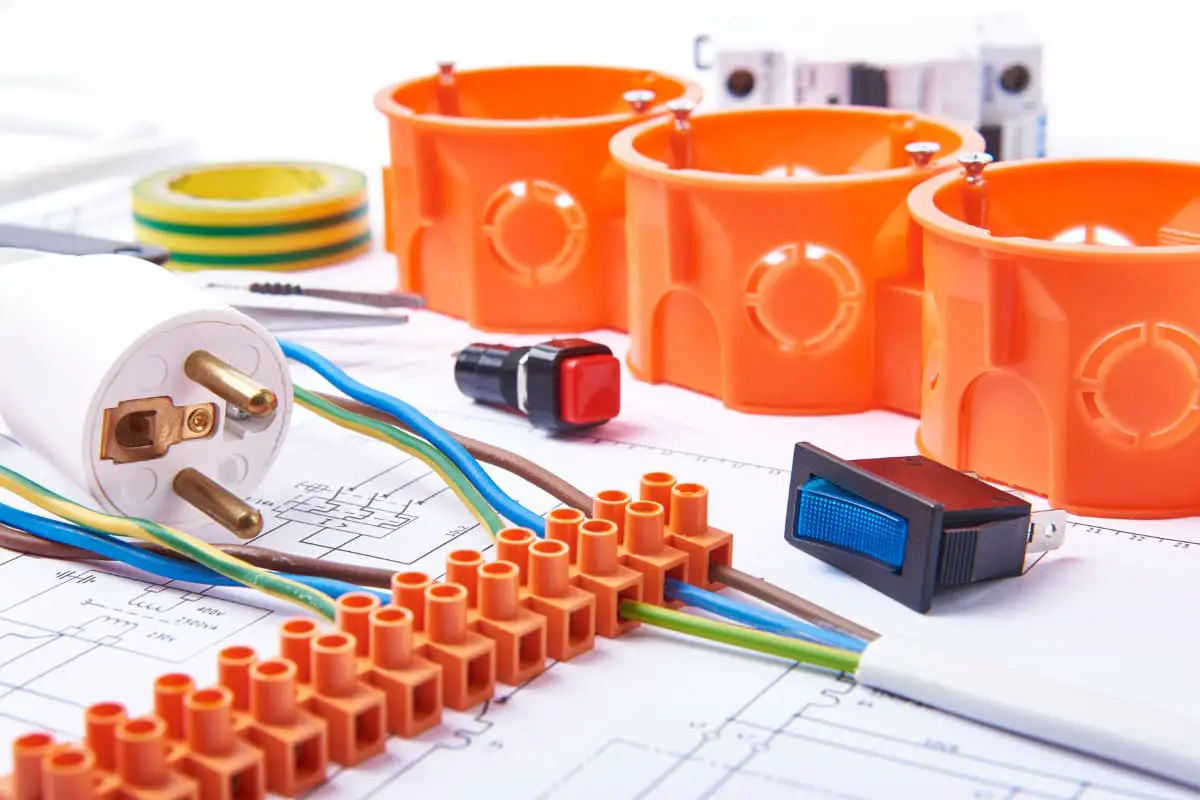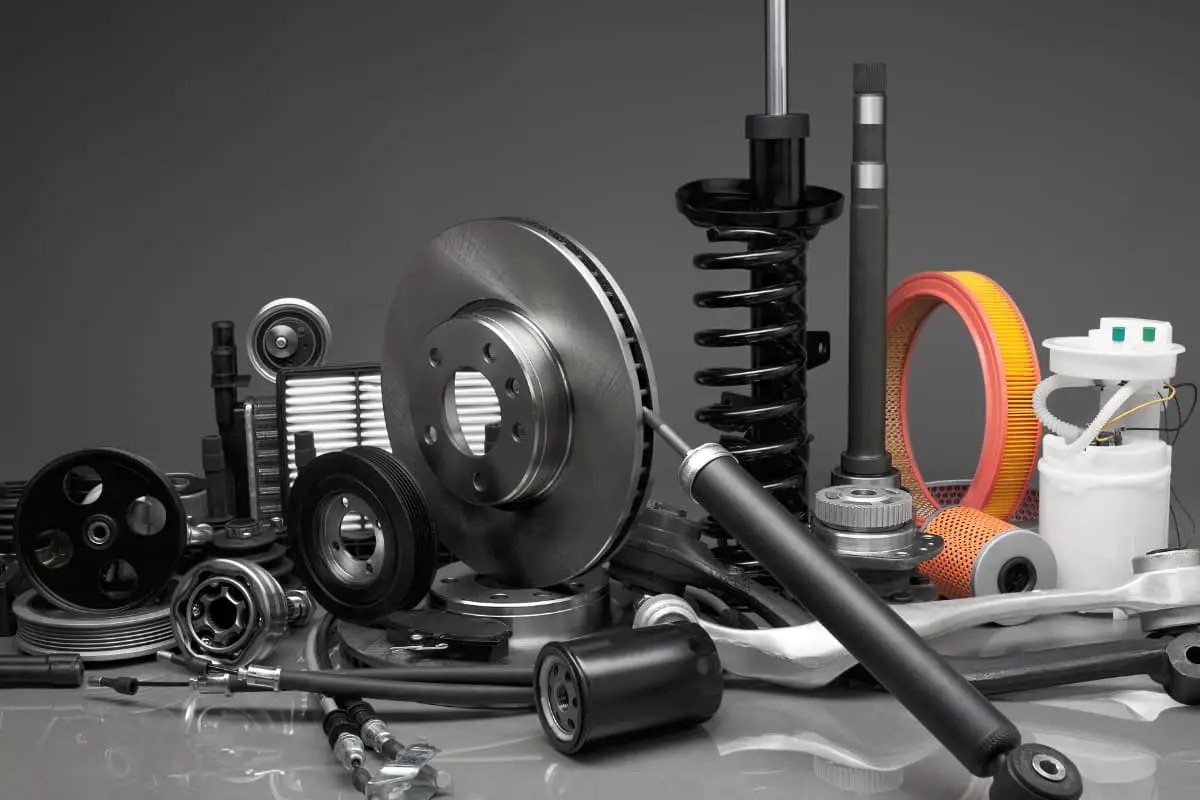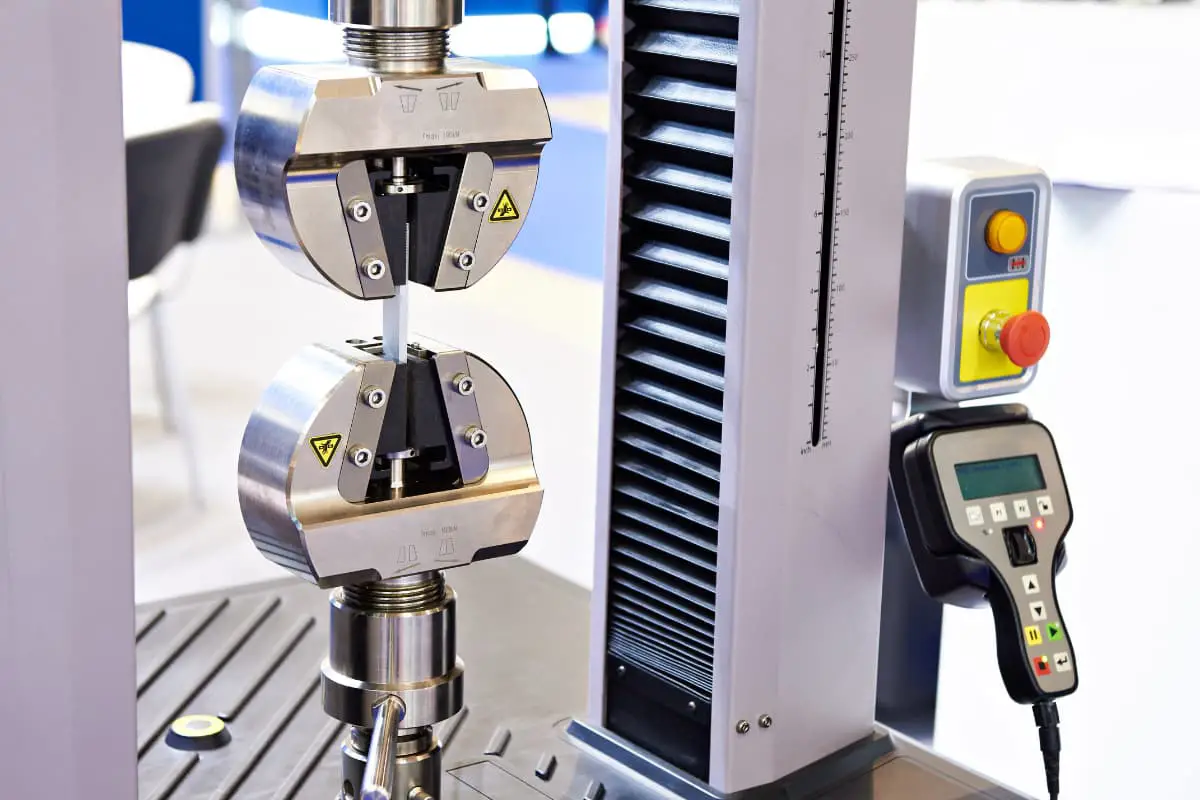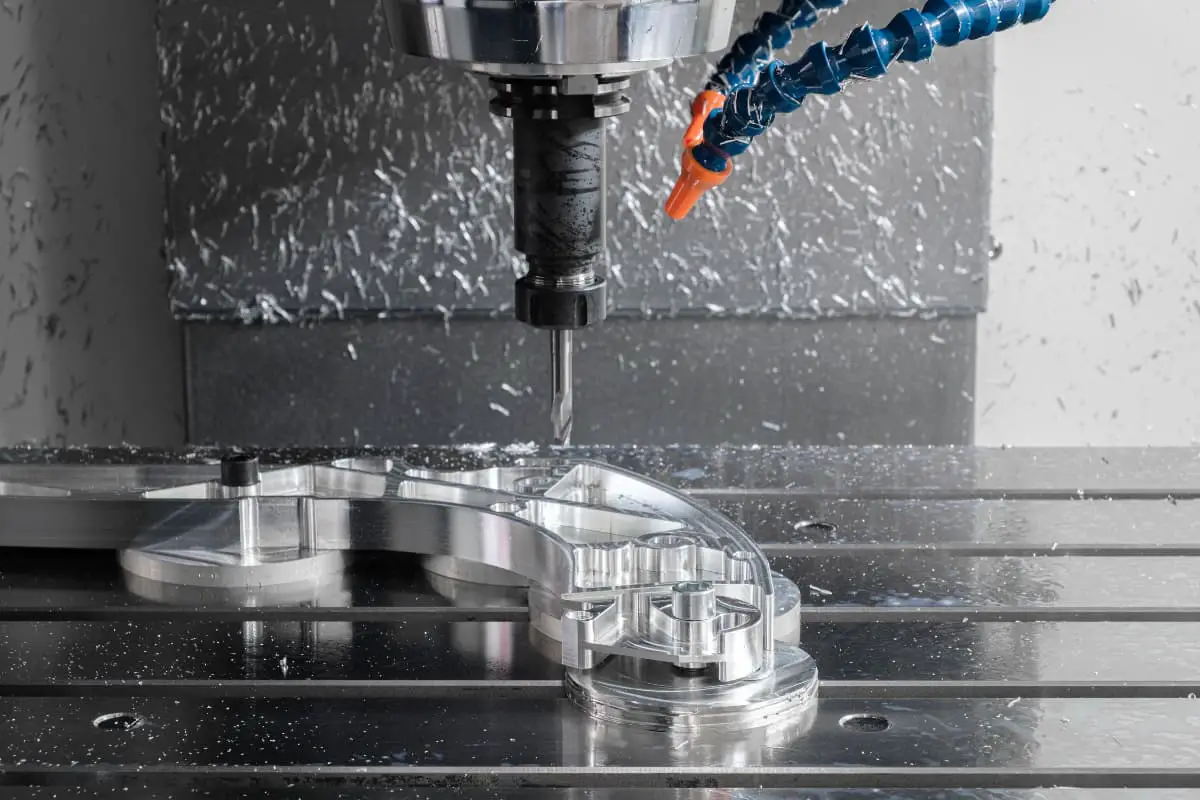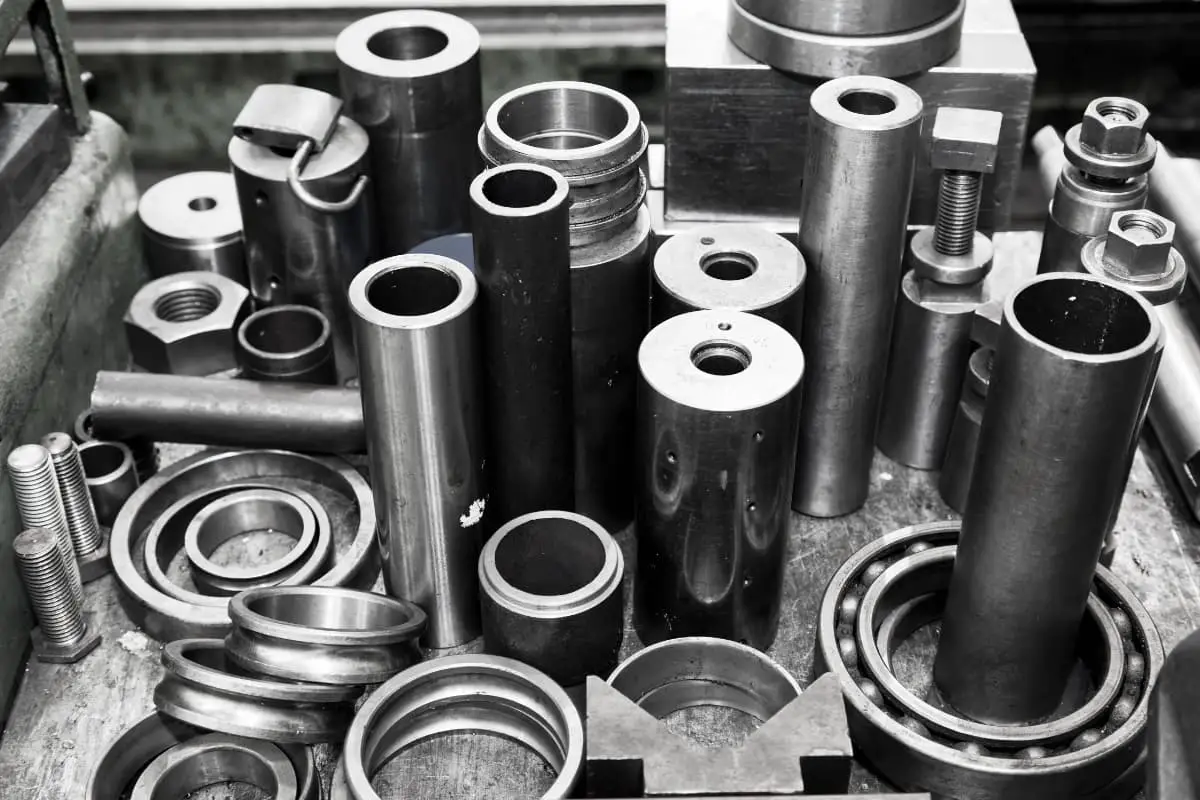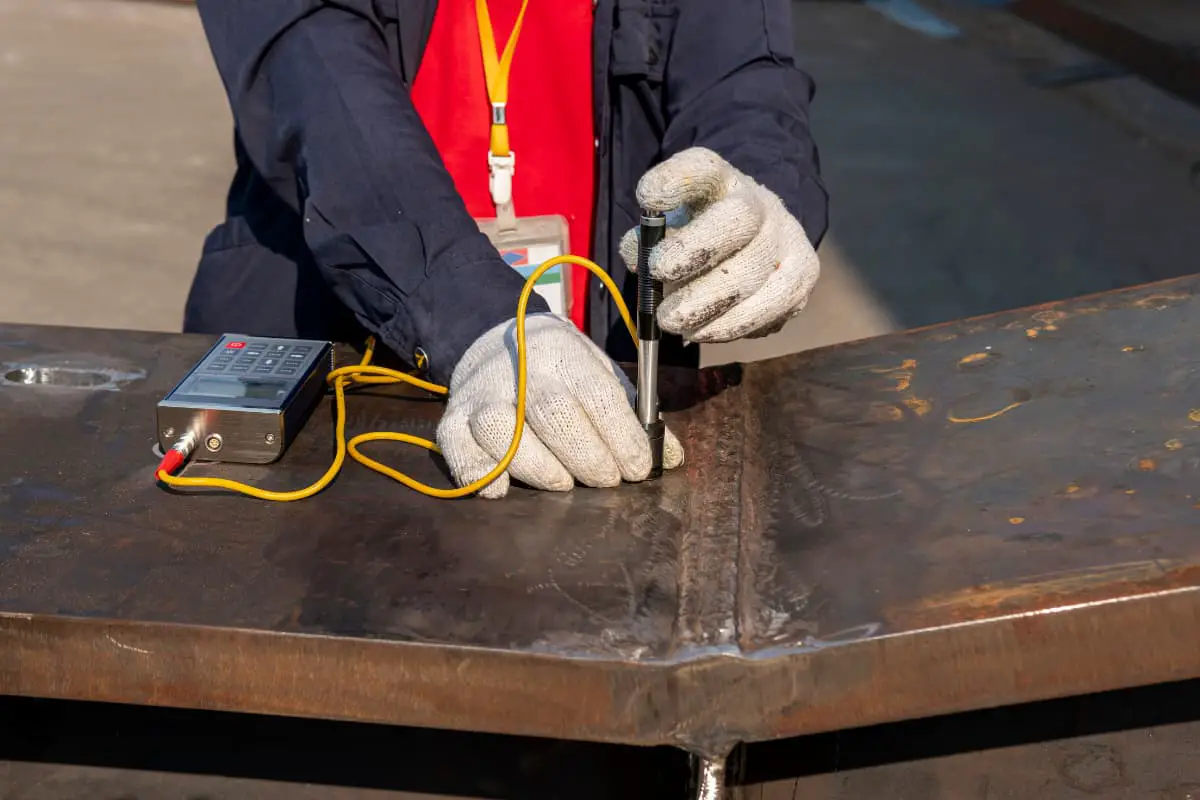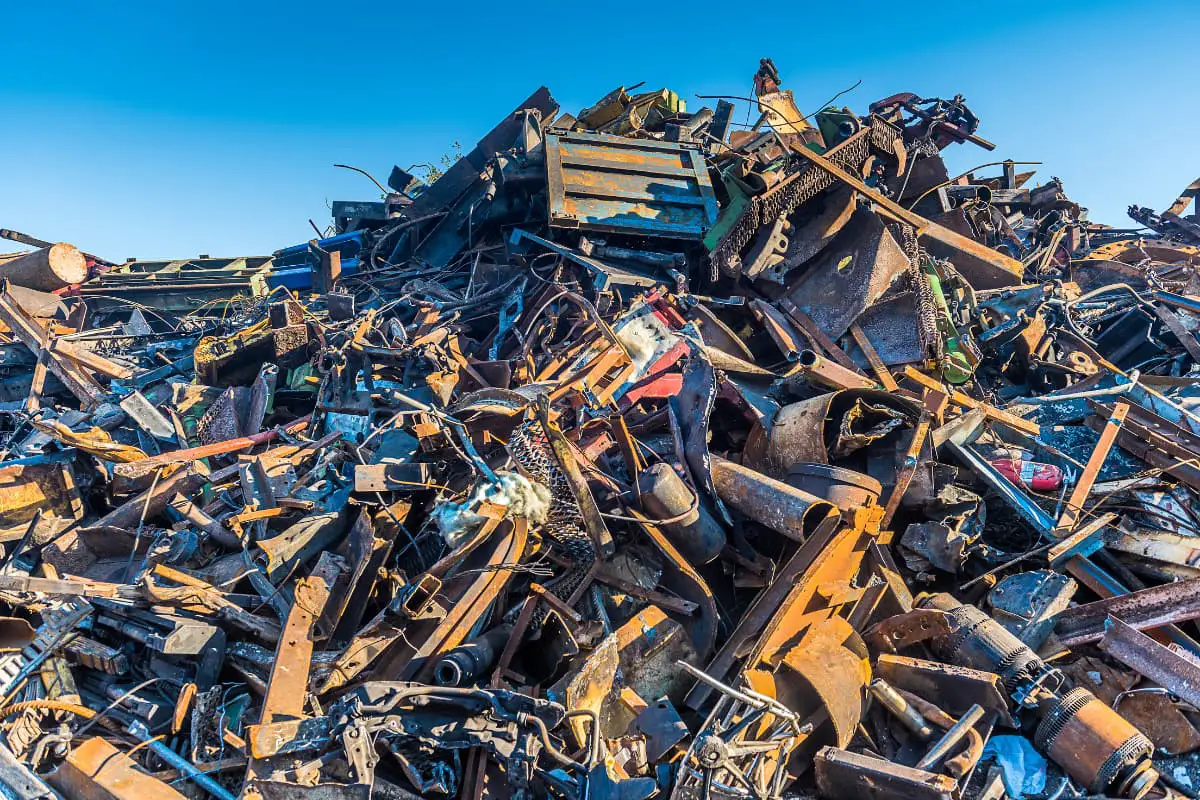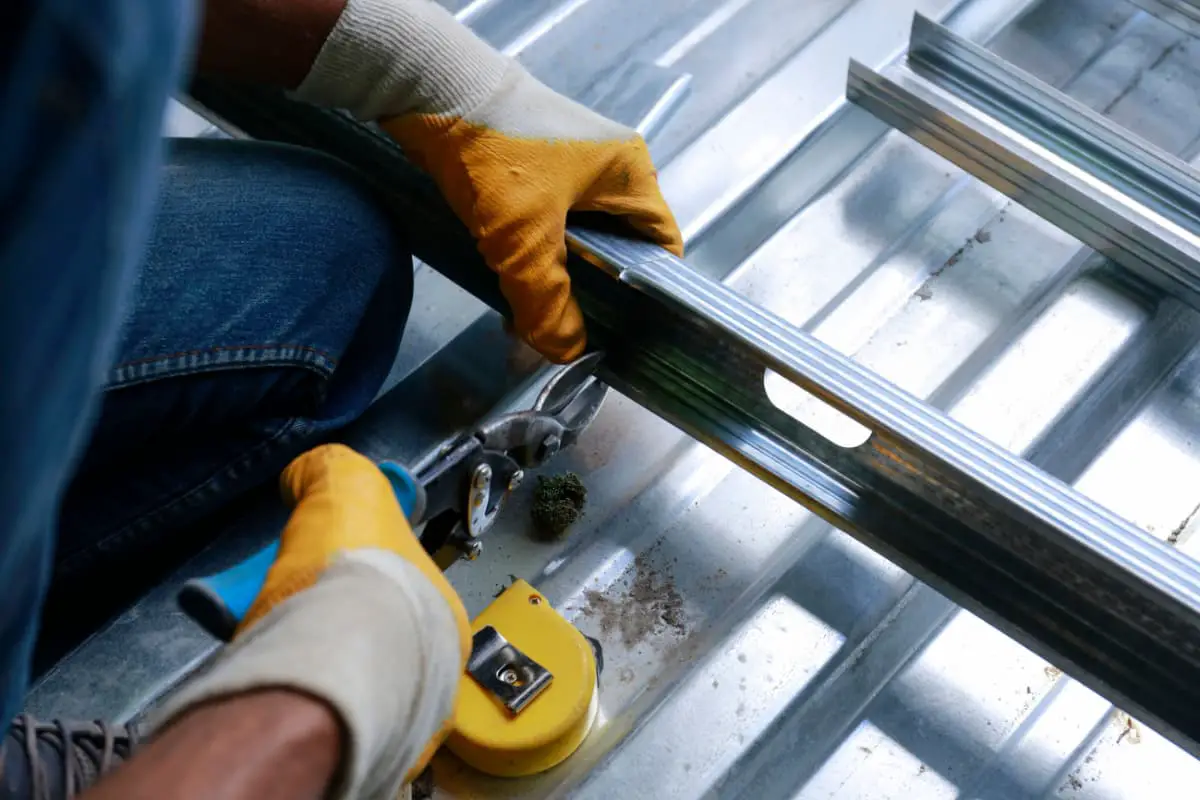
Materials, energy, and information are considered the three pillars of modern industry, and the development of energy and information, to some extent, depends on the progress of materials. According to statistics, a car is composed of about 30,000 parts, and these parts are made from more than 4,000 different materials.
From the design, material selection, and manufacturing of a car to its use, maintenance, and care, materials are involved in every aspect. Taking modern car materials as an example, in terms of weight, steel accounts for 55% to 60% of the car’s weight, cast iron accounts for 5% to 12%, non-ferrous metals account for 6% to 10%, plastics account for 8% to 12%, rubber accounts for 4%, glass accounts for 3%, and other materials (paint, various liquids, etc.) account for 6% to 12%. Figure 1 shows the proportion of various materials used in the Boeing 767 aircraft.
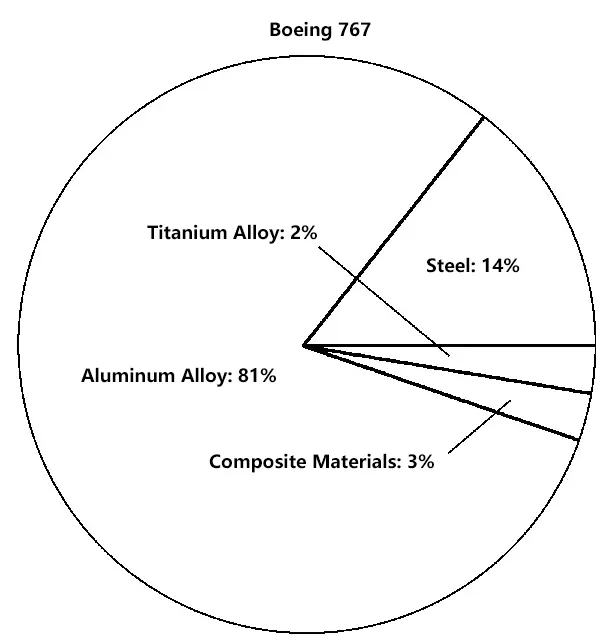
Engineering materials are the material basis for constructing machinery. The performance of machinery depends on the materials used. There are thousands of materials used in machinery manufacturing, and making the right choice among so many materials is not easy.
Engineering materials are diverse and widely used. In engineering, materials are usually classified according to the chemical classification method, which can be divided into metal materials, inorganic non-metallic materials (ceramics), organic polymer materials, and composite materials, as shown in Figure 2.
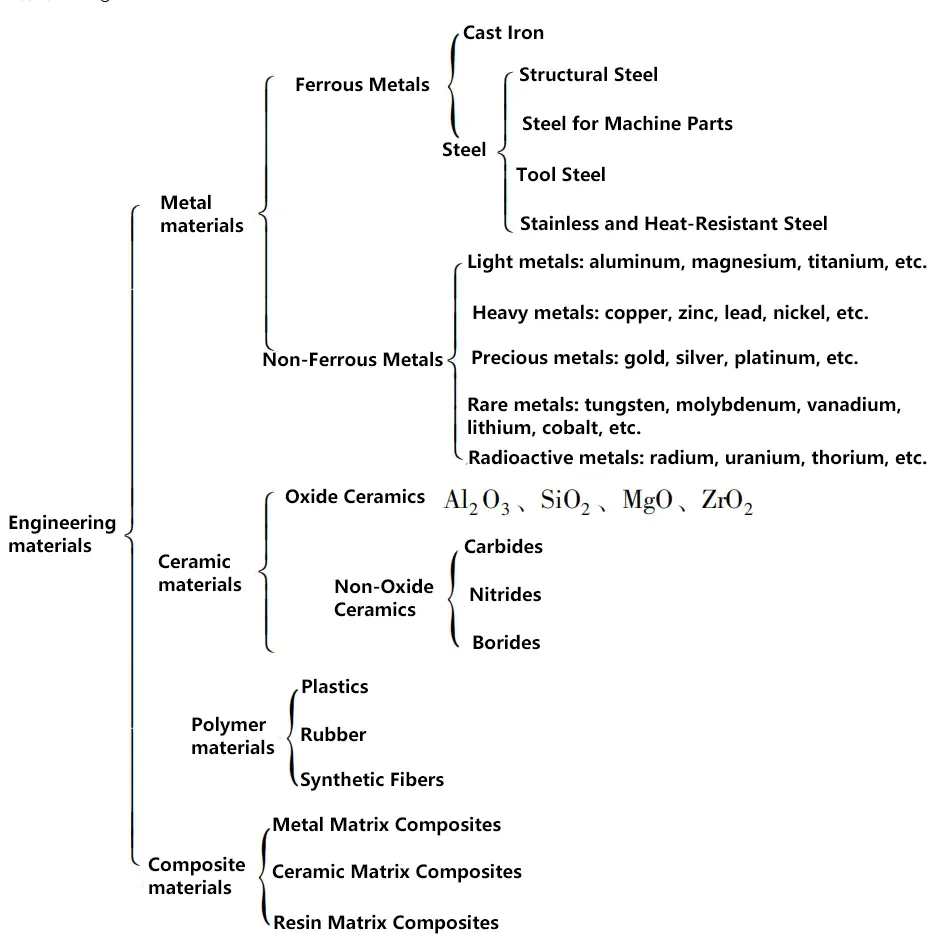
I. Metal materials
Metal materials are a general term for metals and their alloys, including ferrous metals and non-ferrous metals, accounting for 80% of the total usage. The characteristics of metals are determined by the nature of metallic bonds.
Metal materials have good mechanical properties (high strength, stiffness, plasticity, toughness) and certain physical and chemical properties (good electrical and thermal conductivity, etc.) and good workability. They are inexpensive or moderately priced, widely used as structural materials, and some are used as functional materials, but resources are limited. Metal materials cannot work in extremely high temperatures and special media.
According to the constituent elements, metal materials can be divided into ferrous metals and non-ferrous metals. Ferrous metals include iron and iron-based alloys, such as pure iron, carbon steel, alloy steel, cast iron, and ferroalloys, collectively referred to as steel materials. Non-ferrous metals include metals other than iron and their alloys, commonly used ones are gold, silver, aluminum and aluminum alloys, copper and copper alloys, titanium and titanium alloys, etc.
According to the main properties and uses, metal materials can be divided into metal structural materials and metal functional materials. According to the processing technology, metal materials can be divided into cast metal materials, deformed metal materials, and powder metallurgy materials. According to density, metal materials are divided into light metals (density <4.5g/cm³) and heavy metals (density >4.5g/cm³).
1. Steel materials
Steel materials can be divided into industrial pure iron, steel, and cast iron. Industrial pure iron is an iron-carbon alloy with a carbon content of no more than 0.02%. Although industrial pure iron has good plasticity, its strength is low and it is rarely used as a structural material and appearance material.
Steel is an iron-carbon alloy with a carbon content of 0.02% to 2.11%, and also contains small amounts of impurity elements such as phosphorus and sulfur. There are many types of steel, which can be divided into carbon steel and alloy steel according to chemical composition, and are widely used in various fields. Cast iron is an iron-carbon alloy with a carbon content of 2.11% to 4.0%.
Cast iron is an important engineering material with a long history of use. It has a low melting point, good casting performance, machinability, wear resistance, and vibration damping, simple production process, and low cost. It can be used to manufacture various parts with complex structures and shapes. Common cast iron materials include gray cast iron, malleable cast iron, and ductile cast iron.
Carbon steel can be divided into ordinary steel, high-quality steel, and high-grade high-quality steel according to quality; according to use, it can be divided into structural steel, tool steel, and special performance steel; according to carbon content, it can be divided into low carbon steel (carbon content below 0.25%), medium carbon steel (carbon content 0.25% to 0.6%), and high carbon steel (carbon content above 0.6%).
Low carbon steel has low strength, high plasticity, high toughness, and good workability and weldability, suitable for manufacturing parts and components with complex shapes and requiring welding; medium carbon steel has certain strength, plasticity, and moderate toughness, with good comprehensive mechanical properties after heat treatment, and is mostly used for manufacturing mechanical parts requiring strength and toughness such as gears and bearings; high carbon steel has high strength and hardness, good wear resistance, low plasticity and toughness, mainly used for manufacturing tools, cutting tools, springs, and wear-resistant parts.
Alloy steel is steel based on carbon steel with the addition of one or several alloy elements, having higher comprehensive mechanical properties and certain special physical and chemical properties. Alloy elements can improve the performance and processability of steel, commonly used ones are silicon, manganese, chromium, nickel, aluminum, tungsten, titanium, boron, etc. For example, chromium can increase the wear resistance, hardness, and high-temperature strength of steel.
Alloy steel can be divided into low alloy steel (total content below 5%), medium alloy steel (total content 5% to 10%), and high alloy steel (total content above 10%) according to the total content of alloy elements; according to the types of alloy elements, it can be divided into chromium steel, nickel steel, manganese steel, silicon steel, chromium-nickel steel, manganese-silicon steel, etc.; according to use, it can be divided into alloy structural steel, alloy tool steel, and special alloy steel (such as stainless steel, heat-resistant steel, wear-resistant steel, etc.).
2. Non-ferrous metal materials
(1) Aluminum and aluminum alloys are the most widely used non-ferrous metals in industry and are commonly used modern materials with the following characteristics.
- Pure aluminum has a low density, about 2.7g/cm³, which is about 1/3 of copper, and belongs to light metals.
- Melting point is 660°C.
- Aluminum has excellent electrical and thermal conductivity, second only to copper, with an electrical conductivity of about 64% of copper.
- Aluminum has high plasticity and can undergo various plastic processing.
- Pure aluminum is silver-white and has good oxidation resistance in the atmosphere, but chloride ions and alkali ions can destroy the oxide film of aluminum, making it not resistant to acid, alkali, and salt corrosion.
Aluminum alloy is an alloy composed of aluminum as the base and adding other alloy elements (copper, silicon, magnesium, zinc, manganese, nickel, etc.). Aluminum alloy is light, strong, with a specific strength value close to or exceeding that of steel, has excellent electrical conductivity, thermal conductivity, and corrosion resistance, is easy to process, resistant to impact, and can be anodized into various colors.
Aluminum alloys are usually divided into wrought aluminum alloys and cast aluminum alloys. Wrought aluminum alloys, also known as pressure-processed aluminum alloys, have good plasticity and can be made into products such as plates, rods, tubes, and profiles through rolling, extrusion, drawing, forging, and other cold and hot processing methods. They are excellent lightweight materials. They are further divided into rust-proof aluminum alloys, hard aluminum alloys, and super-hard aluminum alloys.
Cast aluminum alloys have good casting performance and certain mechanical properties, but poor plasticity and cannot undergo plastic processing. They are mostly produced using sand casting, metal casting, and investment casting methods to produce castings with complex shapes, light weight, and certain corrosion and heat resistance requirements. They are further divided into aluminum-silicon, aluminum-copper, aluminum-magnesium, and aluminum-zinc alloys according to the main alloy elements.
Common aluminum alloy products include aluminum alloy profiles, aluminum alloy decorative panels, aluminum foil, aluminum-plastic composite films, and vacuum aluminized films.
(2) Copper and copper alloys are the earliest non-ferrous metals used in history. Commonly used in industry are red copper, brass, bronze, white copper, etc., and they have the following characteristics.
- Pure copper has a rose color, and after surface oxidation, it appears purple, hence it is also called red copper.
- The melting point of pure copper is 1083℃, and its density is 8.96g/cm³.
- Pure copper is soft, has excellent ductility, good workability and weldability, and can be easily formed by cold and hot processing. It can be rolled into extremely thin copper foil and drawn into extremely fine copper wire.
- Pure copper has excellent electrical and thermal conductivity, second only to silver.
- Pure copper has strong anti-magnetic properties and is commonly used as an electrical conductor and in various anti-magnetic devices.
Copper alloys are alloys composed of copper as the base material with a certain amount of other alloying elements (zinc, tin, aluminum, silicon, nickel, etc.). They are classified by chemical composition into brass, bronze, and white copper; and by processing methods into wrought copper alloys and cast copper alloys.
Brass (Cu-Zn alloy) is a copper alloy with zinc as the main alloying element. Brass has a beautiful appearance with a noble golden color, strong electrical and thermal conductivity, good corrosion resistance, mechanical properties, and workability. It is easy to cut, polish, and weld, and can be made into sheets, strips, tubes, rods, and profiles. It is used as thermal and electrical conductive components, corrosion-resistant structural parts, elastic components, cold stamping parts, deep drawing parts, daily hardware, and decorative materials.
Bronze is a general term for other copper-based alloys except for brass and white copper. Common alloying elements include tin, aluminum, silicon, manganese, chromium, etc. Bronze is divided into ordinary bronze and special bronze.
Ordinary bronze uses tin as the main alloying element, with a tin content of 5% to 20%, also known as tin bronze (Cu-Sn alloy). It has a blue-gray color and strong corrosion resistance. It is further divided into wrought tin bronze and cast tin bronze.
Wrought tin bronze has a tin content of less than 6% to 7%, with good mechanical properties and workability, wear resistance, and can be processed into various specifications of sheets, strips, tubes, and rods.
Cast tin bronze has a tin content of 10% to 14%, is relatively hard, has good castability, and can be used to produce castings with complex shapes and clear contours. Special bronze generally refers to bronze that does not contain tin, such as aluminum bronze, beryllium bronze, manganese bronze, etc. Most special bronzes have higher mechanical properties, wear resistance, and corrosion resistance than ordinary bronze.
White copper (Cu-Ni alloy) is a copper alloy with nickel as the main alloying element. It has a white color, is relatively soft, and has good corrosion resistance. As the nickel content in copper alloys increases, the strength, hardness, elasticity, and corrosion resistance of white copper also increase. White copper includes ordinary white copper and special white copper.
Ordinary white copper is an alloy composed only of copper and nickel. Special white copper is an alloy of copper and nickel with the addition of other alloying elements such as zinc, aluminum, manganese, etc., like zinc white copper, aluminum white copper, manganese white copper, etc. Industrially, white copper is divided into structural white copper and electrical white copper.
II. Ceramic Materials
Ceramics are inorganic polymer materials made from natural or synthetic powdered compounds through forming and high-temperature sintering into polycrystalline solid materials. They have excellent physical and chemical properties (corrosion resistance, optical, electrical, thermal properties, insulation properties, etc.) and excellent high-temperature resistance, with a wide range of raw material sources. They are mainly used in special applications (special ceramics) and daily use (traditional ceramics). However, they are brittle, difficult to process, and have poor reliability.
Ceramics can be classified by use into ordinary ceramics, special ceramics, and metal ceramics.
1. Ordinary Ceramics
Ordinary ceramics are made from clay, feldspar, and quartz as raw materials and sintered. The advantages are hardness, non-oxidation, non-rusting, high-temperature resistance; good formability, and low cost.
The disadvantages are low strength, and insulation and high-temperature resistance are not as good as other ceramics. They are widely used in various daily ceramic products, electrical porcelain insulators, acid and alkali-resistant containers, and reaction tower pipelines, and textile machinery guide parts.
2. Special Ceramics
Special ceramics include alumina ceramics, silicon carbide ceramics, silicon carbide ceramics, and boron nitride ceramics.
(1) Alumina Ceramics
Alumina ceramics (composition: Al₂O₃ as the main crystal phase, with a small amount of SiO₂) have the advantages of high hardness, high-temperature resistance (oxidation resistance, high creep resistance), corrosion resistance, and good insulation properties; the disadvantages are high brittleness and poor thermal shock resistance. They are used to manufacture wear-resistant parts such as bearings, spark plugs for internal combustion engines, rocket and missile nose cones, synthetic fiber nozzles, and various cutting tools.
(2) Silicon Nitride Ceramics
Silicon nitride ceramics (main component: Si₃N₄) are prepared by two methods: hot pressing sintering and reaction sintering. The performance characteristics are high hardness, low friction coefficient, excellent wear resistance, high creep resistance, low thermal expansion coefficient, and the best thermal performance. They have good chemical stability (except for hydrofluoric acid) and excellent insulation properties.
They can be used in wear-resistant, high-temperature, corrosion-resistant, and complex-shaped, high-precision ceramic products such as crucibles, insulating parts, high-temperature bearings, gas turbine rotor blades, and can also be used to make thermocouple protection tubes, sealing rings for petrochemical pumps (dynamic seals), and cutting tools.
(3) Silicon Carbide Ceramics
Silicon carbide ceramics (main component: SiC) are prepared by reaction sintering and hot pressing sintering. They have high-temperature strength, good thermal conductivity, resistance to radiation from radioactive elements, good thermal stability, creep resistance, and corrosion resistance. They are used in high-temperature structural materials such as rocket nozzle nozzles, high-temperature bearings, heat exchangers, and nuclear fuel cladding materials.
(4) Boron Nitride Ceramics
The crystal structure of boron nitride ceramics (main component: BN) is hexagonal, similar to graphite, and is called “white graphite.” It has characteristics such as heat resistance, thermal conductivity, thermal stability, and good thermal shock resistance, and can be used in control rods that absorb thermal neutrons in nuclear reactors.
3. Cermet
The composition of cermet is metal oxides or carbides with an appropriate amount of metal powder (Al2O3, ZnO, TiC, WC, etc. + Co, Ni, Cr, Fe, Mo, etc.). Its preparation method is powder metallurgy (process: powder making → pressing and forming → sintering → post-processing, etc.).
It has characteristics such as high hardness, high thermal hardness, high wear resistance, high compressive strength, low flexural strength, high elastic modulus, good corrosion resistance, lower thermal expansion coefficient than steel, high brittleness, and good thermal conductivity. Cermet can be divided into three categories: tungsten-cobalt, tungsten-cobalt-titanium, and universal hard alloy.
- The composition of tungsten-cobalt type is WC+Co, with typical grades YG3, YG6, YG8. It can be used to manufacture tools for cutting brittle materials, such as cast iron, some non-ferrous metals, and bakelite.
- The composition of tungsten-cobalt-titanium type is WC+Ti+Co, with typical grades YT5, YT15, YT30. It can be used to manufacture tools for cutting tough materials, such as steel.
- The composition of universal hard alloy is WC+TiC+TaC+Co, with typical grades YW1, YW2. It can be used to manufacture tools that can cut both brittle and tough materials, with good processing results.
III. Polymer Materials
Polymers, also known as macromolecules, are large molecules formed by thousands to millions of atoms linked together by covalent bonds. Therefore, they are also called macromolecules or polymers. The characteristics of polymers are large molecular weight, up to 10^4 to 10^6, and molecular weight polydispersity. Their relative molecular mass is generally in the tens of thousands to millions.
Polymer materials can be divided into natural organic polymer materials (wood, natural rubber, asphalt, etc.) and synthetic organic polymer materials (plastics, rubber, chemical fibers) according to their sources. They can also be divided into thermoplastic polymers and thermosetting polymers according to their properties when heated.
The advantages of polymer materials are low density, high elasticity, wear resistance, insulation, corrosion resistance, light weight, high specific strength (lightweight and high-strength materials), low thermal conductivity (good thermal insulation), good processability, and abundant raw materials. The disadvantages are poor mechanical properties, especially low strength, not resistant to high temperatures (≤300°C), flammability, and the release of toxic gases during combustion, and they age over time.
Polymer materials can be divided into three categories: plastics, rubber, and fibers.
1. Plastics
Plastics are polymer materials with plasticity used in the glassy state. They are composed mainly of resins, with various additives added, and can be processed and formed under certain temperatures and pressures. Plastics can be divided into thermoplastics and thermosetting plastics.
(1) Thermoplastics
Thermoplastics are plastics that can be repeatedly softened by heating and hardened by cooling within a certain temperature range.
Common thermoplastics include polyethylene (PE), polypropylene (PP), polystyrene, polymethyl methacrylate (PMMA), and polyvinyl chloride (PVC). Among them, polyethylene has the largest production volume and the simplest structure; polypropylene is the lightest plastic; polyvinyl chloride is the most versatile plastic and is inexpensive; polymethyl methacrylate is the most transparent plastic and is known as unbreakable glass.
(2) Thermosetting Plastics
Thermosetting plastics are plastics that become permanently fixed in shape after heating (or without heating) and cannot be remelted and reshaped once formed. They have good heat resistance and creep resistance.
Common thermosetting plastics include phenolic resin, epoxy resin, and polyester resin. Phenolic resin can be used as electrical insulation material; epoxy resin can be used as composite material and adhesive; polyester resin can be used to make fiberglass.
Plastics can also be divided into general-purpose plastics, engineering plastics, and special plastics based on their usage.
(1) General-purpose Plastics
General-purpose plastics are plastics with large production volumes, wide applications, and low prices. They mainly include polyethylene, polyvinyl chloride, polystyrene, polypropylene, phenolic plastics, phenolic and urea-formaldehyde plastics, etc. They account for more than 75% of the total plastic production and are widely used in daily necessities, packaging, agriculture, and other fields.
(2) Engineering Plastics
Engineering plastics are plastics that can withstand certain external forces, have high strength and rigidity, and have good dimensional stability. They can replace metals to manufacture mechanical parts and engineering components. Common engineering plastics include polyamide (PA), polycarbonate (PC), polyoxymethylene (POM), polytetrafluoroethylene (PTFE), ABS, polymethyl methacrylate, and epoxy resin.
Among them, polyamide is the most produced and earliest developed engineering plastic; polycarbonate is non-toxic, tasteless, transparent, and has the best impact resistance; polyoxymethylene has self-lubricating properties and high dimensional stability; polytetrafluoroethylene has the lowest friction coefficient and is known as the king of plastics.
(3) Special Plastics
Special plastics have special properties such as heat resistance and self-lubrication and can be used for special requirements, such as conductive plastics, magnetic plastics, and photosensitive plastics. Common special plastics include fluoroplastics, silicone plastics, and polyimides.
2. Rubber
Rubber is a high-elasticity polymer material with reversible deformation. It is elastic at room temperature and can undergo significant deformation under very small external forces, returning to its original state once the external force is removed.
Rubber is a completely amorphous polymer with a low glass transition temperature and often has a very high molecular weight, exceeding hundreds of thousands. It is classified into natural rubber and synthetic rubber based on raw materials; and into block raw rubber, latex, liquid rubber, and powdered rubber based on form.
(1) Natural Rubber
Natural rubber has good elasticity, high strength, good flex resistance, and good insulation properties. These properties are unmatched by synthetic rubber. Therefore, natural rubber remains the most important type of rubber. It also has good processability, adhesiveness, and mixability.
(2) Synthetic Rubber
There are many types of synthetic rubber, which can be classified into general-purpose synthetic rubber, special-purpose synthetic rubber, and other synthetic rubbers (such as thermoplastic elastomers, powdered rubber, liquid rubber, etc.) based on their properties and uses. General-purpose synthetic rubber is typically used to replace natural rubber in the manufacture of tires and other common rubber products, such as styrene-butadiene, butadiene, chloroprene, butyl, polyisoprene, ethylene-propylene, and nitrile rubber.
Special-purpose synthetic rubber has special properties such as resistance to cold, heat, and oil, and is used to manufacture rubber products for specific conditions, such as chlorosulfonated polyethylene, chlorinated polyethylene, silicone rubber, fluororubber, acrylate, epichlorohydrin, and polysulfide rubber.
3. Fibers
Fibers are slender polymer materials with a high length-to-diameter ratio and certain flexibility. Fibers are classified into organic synthetic fibers, inorganic fibers, and natural fibers. Inorganic fibers include metal fibers, carbon fibers, silicon-based fibers, and mineral fibers. Natural fibers include plant fibers (such as hemp and cotton) and animal fibers (such as wool and camel hair).
The main synthetic fibers are polyester, polyamide, and polyacrylonitrile. Polyamide fibers, also known as nylon, were originally a trademark of DuPont. They are characterized by strength, high elasticity, and light weight, with about half used for clothing and half for industrial production.
Polyester fiber, also known as dacron, is the most produced synthetic fiber, with about 90% used for clothing and only about 6% for industrial production. Polyacrylonitrile fibers include homopolymers and copolymers of acrylonitrile, with about 70% used for clothing and only about 5% for industrial production.
IV. Composite Materials
Composite materials are materials composed of two or more solid-phase components in a microscopic or macroscopic form, possessing new properties different from their constituent substances.
They have high specific tensile strength and specific tensile modulus (see Figure 3); their properties can be designed, and they are easy to form into structural components; they have anisotropic and non-uniform characteristics. Composite materials are classified into structural composite materials and functional composite materials based on their use.
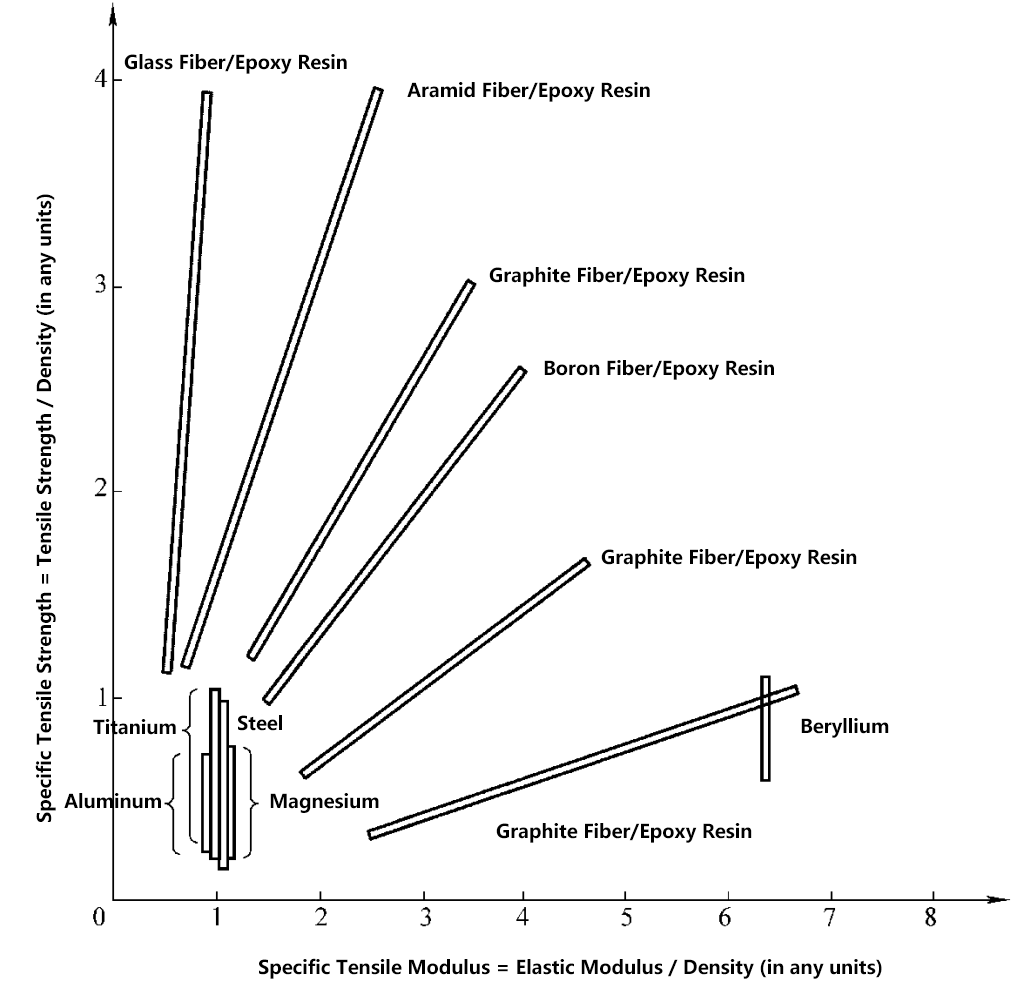
1. Structural Composite Materials
Structural composite materials are mainly used as load-bearing structures, composed of reinforcing components (such as glass, ceramics, carbon, polymers, metals, natural fibers, fabrics, whiskers, sheets, and particles) that can bear loads, and matrix components (such as resins, metals, ceramics, glass, carbon, and cement) that connect the reinforcing components into an integral material and also transmit forces.
Structural composite materials are usually classified based on the matrix into polymer matrix composites, metal matrix composites, ceramic matrix composites, carbon matrix composites, and cement matrix composites.
2. Functional Composite Materials
Functional composite materials refer to composite materials that provide other physical, chemical, biological, and other properties in addition to mechanical properties, including piezoelectric, conductive, radar stealth, permanent magnetic, photochromic, sound-absorbing, flame-retardant, and bio-absorbable materials, among others, with broad development prospects.
In the future, the proportion of functional composite materials will exceed that of structural composite materials, becoming the mainstream of composite material development. Many functional composite materials have already been developed and some have been applied, such as composite piezoelectric materials, conductive and superconducting materials, magnetic materials, damping materials, friction and wear materials, sound-absorbing materials, stealth and wave-absorbing materials, and various sensitive transducer materials.
The main application fields of composite materials include aerospace, energy industry, automotive industry, chemical industry, textile and machinery manufacturing, medical devices, sports equipment, and construction materials.
In the aerospace field, due to the good thermal stability, high specific strength, and high specific stiffness of composite materials, they can be used to manufacture aircraft wings and forebodies, satellite antennas and their support structures, solar cell wings and shells, large launch vehicle shells, engine shells, and space shuttle structural components.
Currently, composite materials account for only 50% of the total weight of commercial aircraft (see Figure 4), while some helicopters have already reached 90%. The Netherlands plans to develop a new type of green, environmentally friendly aircraft, which will resemble a flying saucer in shape. The composite materials used (such as fiber-reinforced plastics) will have strength comparable to metals but much lighter in weight, thus saving fuel (see Figure 5).
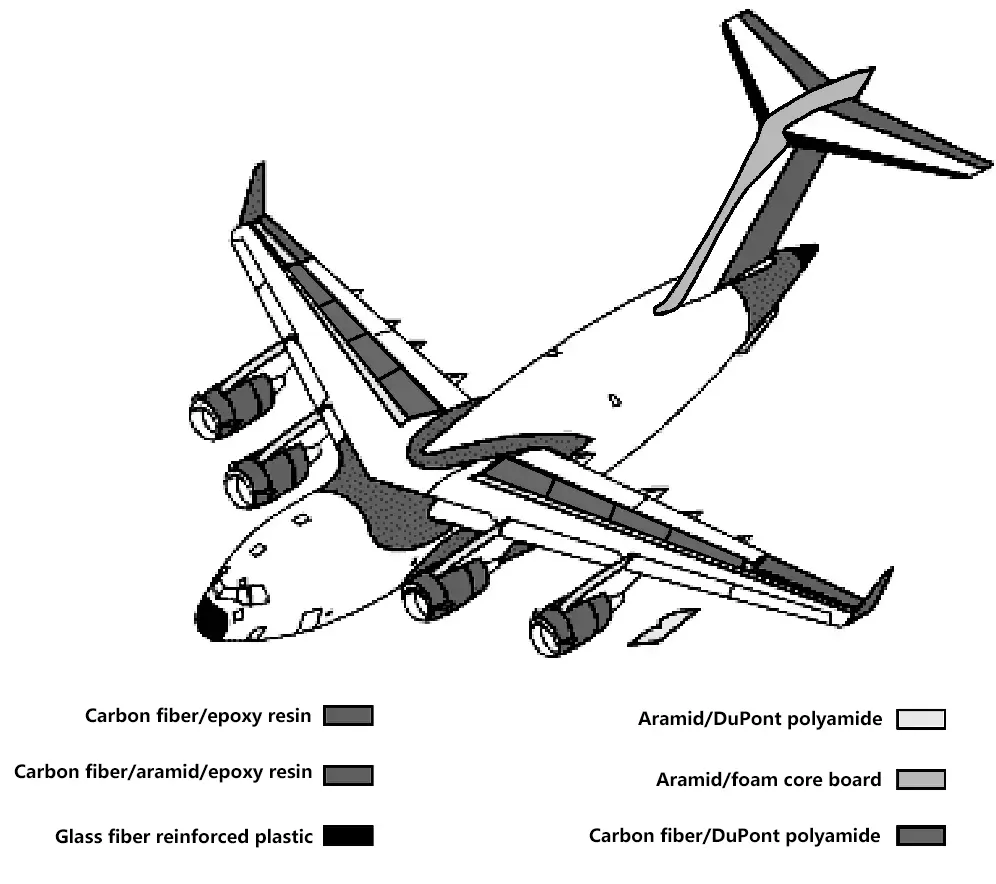

In the automotive industry, due to the special vibration damping properties of composite materials, they can reduce vibration and noise, have good fatigue resistance, are easy to repair after damage, and are convenient for integral molding. Therefore, they can be used to manufacture car bodies, load-bearing components, drive shafts, engine frames, and internal components.
In the chemical, textile, and machinery manufacturing fields, materials with good corrosion resistance, such as carbon fiber reinforced resin matrix composites, can be used to manufacture chemical equipment, textile machines, paper machines, copiers, high-speed machine tools, and precision instruments.
In the medical field, due to the excellent mechanical properties and non-absorption of X-rays of carbon fiber composites, they can be used to manufacture medical X-ray machines and orthopedic braces. Carbon fiber composites also have biocompatibility and blood compatibility, and good stability in biological environments, making them suitable for use as biomedical materials.
Additionally, composite materials are used to manufacture sports equipment and as construction materials. Examples of advanced composite materials in energy technology applications are shown in Table 1.
Table 1 Examples of the application of advanced composite materials in energy technology
| Function | Component | Advanced composite materials |
| New energy | ||
| Solar power generation | Solar cell structure support | Carbon fiber/resin matrix |
| Solar power generation | Absorbing layer of heat exchanger | Absorbing function |
| Wind turbine | Blades and tower body | Hybrid carbon fiber/resin matrix |
| Nuclear energy | Rotor of nuclear isotope separation centrifuge | Carbon fiber/resin matrix |
| Nuclear energy | Nuclear fuel cladding tube | Carbon fiber/carbon |
| Energy saving | ||
| Automobile | Rotating shaft, wheel rim piston | Carbon fiber/resin matrix |
| Automobile | Piston connecting rod and pin | Alumina fiber/aluminum |
| Gas turbine engine | Turbine blade | Ceramic matrix and high-temperature resistant metal matrix |
| Energy Storage | ||
| High-Efficiency Lead-Acid Battery | Electrode | Carbon Fiber/Lead |
| High-Energy Lithium Battery | Solid Electrolyte | Ion Conductive Function |

